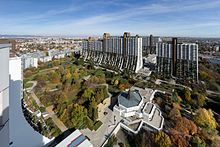Alterlaa




Alterlaa is a residential development in Vienna, Austria, designed by Harry Glück
Design
Completed 1973-1986. Designed to house low income residents[1]
Designed by Harry Glück. One of the largest residential complexes in Austria. Located to the south-west of central Vienna. Conceived as a "city within a city". Built 1970s as a pilot project for the expansion of Vienna with satellite towns. 24 hectares. [2]
Criticised as an Americanism and for its monotony but is often held as an example of good social housing.[3]
Describes teh blocks as ziggurat in style and reminisecent of works carried out by the Public Works Adminstration in New Deal era US. Draw on the designs of Loos and Stnad's Terassenhau of the 1920s. Gluck built a revised version of a Terrassenhaus with a stepped back profile and garden terraces for the Junge Generation housing association in 1971.[4]
Has the highest tenant satisfaction rating in Vienna.[5]
Planning began in 1972 and built from 1975 by GESIBA municipal cooperative agency. Blocks are up to 27-storeys high.[6]
Bottom 12 floors are terraced with 10-15 vertical-sided storeys above. The entrance foyers hold large works of art.[7]
Gluck was inspired by Le Corbusier's ville radieuse.[8]
Features
Has U-Bahn stop, library, newspaper office and schools. Each block has a swimming pool on the roof[9]
Has 3,200 apartments with 65% having at least 3 rooms. Average size is 74.5 sqm and 9,000 people live there. Has a shopping centre, medical facility, kindergartens, playgrounds, tennis courts and a park. 3,400 parking spaces. [2]
In the garden city style with the archicture encouraging horticulture bythe residents. Seven outdoor swimming pools, seven indoor swmimming pools, 20 saunas, 2 indoor tennis centres, four badminton courts. More than 12 doctors offices. Centrally located church and a local TV station.[3]
Residents responsible for the vegeation on their balconies. Large balconies with 4m2 concrete trough platers in front. [1]
References
- ^ a b Ludwig, Ferdinand; Schönle, Daniel (19 December 2022). Growing Architecture: How to Design and Build with Trees. Birkhäuser. p. 103. ISBN 978-3-0356-0339-2.
- ^ a b Johnson, Jeffrey; Brazier, Cressica; Lam, Tat (19 January 2022). The China Lab Guide to Megablock Urbanisms. Actar D, Inc. p. 143. ISBN 978-1-63840-829-1.
- ^ a b Glauser, Andrea (12 March 2020). Vertical Europe: The Sociology of High-rise Construction. Campus Verlag. p. 131. ISBN 978-3-593-51016-3.
- ^ Swenarton, Mark; Avermaete, Tom; Heuvel, Dirk van den (15 September 2014). Architecture and the Welfare State. Routledge. p. 43. ISBN 978-1-317-66190-0.
- ^ Heuvel, Dirk van den; Mesman, Maarten (2008). The Challenge of Change: Dealing with the Legacy of the Modern Movement. IOS Press. p. 406. ISBN 978-1-58603-917-2.
- ^ Glendinning, Miles (25 March 2021). Mass Housing: Modern Architecture and State Power – a Global History. Bloomsbury Publishing. p. 223. ISBN 978-1-4742-2929-6.
- ^ Holan, Eric; Sarne, Berta (1984). Colourful Vienna. Schroll. p. 100. ISBN 978-3-7031-0550-0.
- ^ Lopes, Joao Teixeira; Hutchison, Ray (17 November 2016). Public Spaces: Times of Crisis and Change. Emerald Group Publishing. p. 238. ISBN 978-1-78635-463-1.
- ^ Beanland, Christopher (7 August 2020). Lido: A dip into outdoor swimming pools: the history, design and people behind them. Batsford Books. p. 60. ISBN 978-1-84994-678-0.
